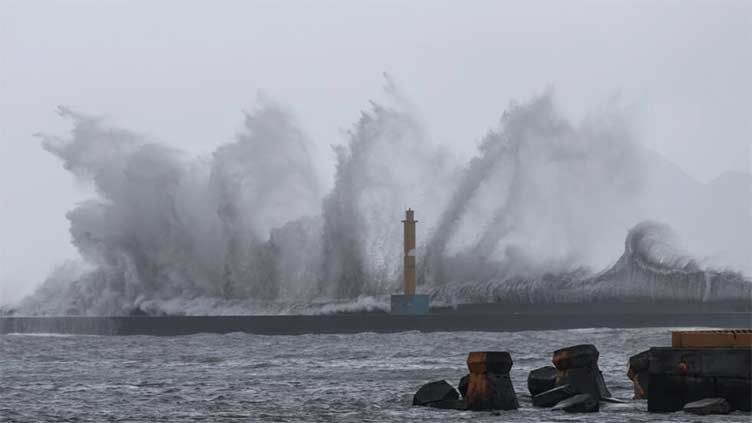Devastation Strikes Taiwan as Typhoon Haikui Leaves Two Injured and Thousands Powerless

Devastation Strikes Taiwan as Typhoon Haikui Leaves 44 Injured and Thousands Powerless
In a harrowing turn of events, Typhoon Haikui unleashed its fury upon Taiwan, causing widespread havoc and leaving a trail of destru/ction in its wake. At least 44 people have been injured, and tens of thousands of homes find themselves plunged into darkness as this powerful typhoon swept across the island. This natural disaster has struck Taiwan with a force not witnessed in four years, igniting fears of flash floods and landslides.
The ominous storm roared ashore along the southeastern coastal township of Donghe, mercilessly pounding the region with its relentless fury at approximately 3:40 p.m. local time, as reported by Taiwan’s Central Weather Bureau. The tempestuous cyclone spared no one in its path, carving a tumultuous course across the island before departing at 8 p.m., leaving a heart-wrenching aftermath.
As the ominous clouds loomed overhead, the authorities were quick to respond, recognizing the imminent threat posed by Typhoon Haikui. Taiwan’s Interior Ministry took swift action, overseeing the evacuation of at least 7,113 individuals across 11 cities and counties. The imperative was clear – protect the lives and well-being of the island’s residents, many of whom faced the daunting prospect of confronting a typhoon of such ferocity for the first time in years.

Before making landfall, Typhoon Haikui was a fearsome force to be reckoned with, boasting wind speeds reaching a staggering 155 kilometers per hour (96 miles per hour), according to the weather bureau. The capital city of Taipei bore the brunt of its wrath, bearing witness to relentless torrents of rain that seemed unrelenting.
The storm’s arrival, while devastating, did not come as a complete surprise to the residents of Taiwan. Meteorological agencies had been monitoring its progress for days, sounding the alarm well in advance. Haikui, the first typhoon to directly strike Taiwan in four years, was a grim reminder of the unpredictable and perilous nature of these weather phenomena.
One of the most alarming aspects of this typhoon was the deluge of rain it brought in its wake. The weather bureau warned that the heavy rainfall accompanying the storm could potentially trigger flash floods and landslides, compounding the misery for Taiwan’s residents. The mountainous Hualien county, in particular, stood to bear the brunt of Haikui’s onslaught, with forecasts predicting total precipitation exceeding a staggering 500 millimeters.
Initially, the typhoon had been projected to make landfall near the southeastern city of Taitung around 5 p.m. local time on Sunday, but its course shifted, taking a more direct and menacing path across Taiwan. This unpredictability further underscored the challenges faced by both meteorologists and emergency responders in dealing with the ever-changing dynamics of typhoons.
As Taiwan grapples with the aftermath of Typhoon Haikui, there is a pressing need for unity and resilience among its people. This disaster has revealed the island’s vulnerability to nature’s wrath and the importance of preparedness in the face of such calamities.
The immediate concern lies in tending to the injured and restoring power to the thousands left in darkness. Emergency response teams are working tirelessly to provide medical assistance to those in need and to assess the extent of the damage. The arduous task of clearing debris from the streets, repairing damaged infrastructure, and restoring power to homes is underway.

The impact of a typhoon extends far beyond the physical damage it inflicts. It disrupts lives, displaces families, and tests the mettle of a community. In such trying times, the resilience and strength of a nation are tested, and Taiwan is no exception.
The government, in collaboration with local authorities and humanitarian organizations, has mobilized resources to provide relief to those affected. Emergency shelters have been set up to provide temporary refuge to displaced families, offering them a safe haven amidst the chaos that surrounds them.
Taiwan’s meteorological agencies continue to closely monitor the situation, issuing warnings and updates to ensure that residents remain informed and vigilant. The potential for further rain and flooding remains a significant concern, and preemptive measures are being taken to mitigate these risks.
Beyond the immediate response, there is also a need to reflect on the lessons learned from Typhoon Haikui. Climate change is altering the dynamics of weather patterns around the world, leading to more frequent and severe typhoons. Taiwan, as an island nation in the western Pacific, is particularly vulnerable to these natural disasters. This serves as a stark reminder of the importance of investing in disaster preparedness, infrastructure resilience, and climate mitigation strategies.

In conclusion, the devastating impact of Typhoon Haikui on Taiwan serves as a somber reminder of the unpredictable forces of nature. While the immediate focus is on recovery and relief efforts, it is imperative that long-term strategies are devised to safeguard the island and its people from future typhoons. The resilience and unity demonstrated by Taiwan’s residents and authorities in the face of this disaster are commendable, and they serve as a testament to the strength of the human spirit in times of adversity.






